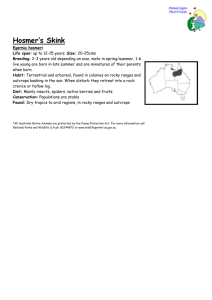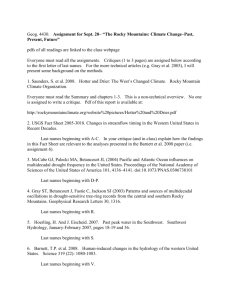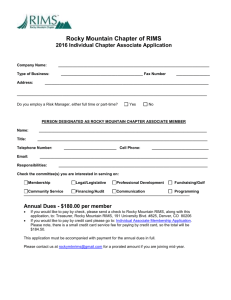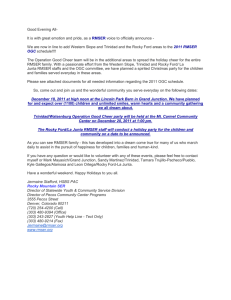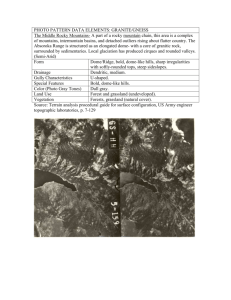Instructor's Manual
advertisement
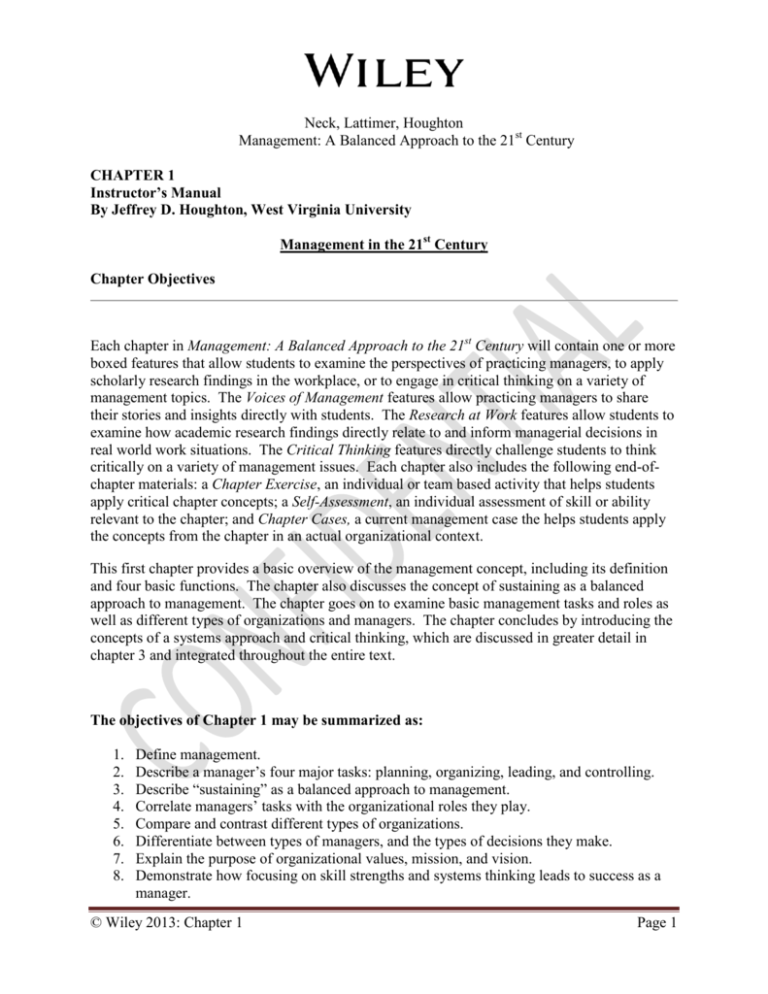
Neck, Lattimer, Houghton Management: A Balanced Approach to the 21st Century CHAPTER 1 Instructor’s Manual By Jeffrey D. Houghton, West Virginia University Management in the 21st Century Chapter Objectives Each chapter in Management: A Balanced Approach to the 21st Century will contain one or more boxed features that allow students to examine the perspectives of practicing managers, to apply scholarly research findings in the workplace, or to engage in critical thinking on a variety of management topics. The Voices of Management features allow practicing managers to share their stories and insights directly with students. The Research at Work features allow students to examine how academic research findings directly relate to and inform managerial decisions in real world work situations. The Critical Thinking features directly challenge students to think critically on a variety of management issues. Each chapter also includes the following end-ofchapter materials: a Chapter Exercise, an individual or team based activity that helps students apply critical chapter concepts; a Self-Assessment, an individual assessment of skill or ability relevant to the chapter; and Chapter Cases, a current management case the helps students apply the concepts from the chapter in an actual organizational context. This first chapter provides a basic overview of the management concept, including its definition and four basic functions. The chapter also discusses the concept of sustaining as a balanced approach to management. The chapter goes on to examine basic management tasks and roles as well as different types of organizations and managers. The chapter concludes by introducing the concepts of a systems approach and critical thinking, which are discussed in greater detail in chapter 3 and integrated throughout the entire text. The objectives of Chapter 1 may be summarized as: 1. 2. 3. 4. 5. 6. 7. 8. Define management. Describe a manager’s four major tasks: planning, organizing, leading, and controlling. Describe “sustaining” as a balanced approach to management. Correlate managers’ tasks with the organizational roles they play. Compare and contrast different types of organizations. Differentiate between types of managers, and the types of decisions they make. Explain the purpose of organizational values, mission, and vision. Demonstrate how focusing on skill strengths and systems thinking leads to success as a manager. © Wiley 2013: Chapter 1 Page 1 Neck, Lattimer, Houghton Management: A Balanced Approach to the 21st Century Chapter Outline 1.1 What Is Management? Management is the process of working with people and distributing an organization’s resources to achieve goals efficiently and effectively. The four things every organization needs to be successful: 1) Access to resources 2) Effective leaders 3) Competent employees 4) Interested consumers/advocates What do managers do? People-focused vs. technically-focused How is management both art and science? People-focused duties are “art of management” Collaborating and communicating with a team to pursue a goal Technically-focused duties are “science of management” Observing and gathering the necessary information to achieve set goals How do managers make a difference? “3 P’s” – people, profit, planet People – invest in wellness programs, training and education, retirement accounts, healthcare benefits, career advancement opportunities, and flexible environments Profit – ensure company is financially healthy so it can offer employees stable jobs, hire new college graduates, reward investors, and support local and global causes Planet – protecting and supporting the environment and community to ensure that the organization is still around in 100 years Corporate Social Responsibility is an organization’s self-defined commitment to the health and well-being of the local and global community beyond its legal obligations Milton Friedman – maximize shareholders’ wealth Managers that build sustainable organizations do so by balancing needs and results for people, profit, and the planet. 1.2 The Four Management Functions Henri Fayol’s principles: planning, organizing, commanding, coordinating, controlling © Wiley 2013: Chapter 1 Page 2 1.3 1.4 Neck, Lattimer, Houghton Management: A Balanced Approach to the 21st Century Traditional view- management functions are separate steps in linear process Today’s View- management functions are overlapping and interconnected Planning is the process of setting goals for the future, designing appropriate strategies, and deciding on the actions and resources needed to achieve success. Working towards a specific destination is imperative to being successful in business. Organizational planning has evolved from a centralized activity - performed only by a handful of top managers - to a process that starts with management’s clear sense of the company’s purpose, which it communicates directly to its customers, employees, and communities. Organizing is the process of orchestrating people, actions, resources, and decisions to achieve goals. Once a plan is in place, a team of people must be assembled to implement the plan. Leading is the process of effectively motivating and communicating with people to achieve goals. Understanding what motivates employee behavior and communicating effectively with a diverse team are even more critical for a manager when the team experiences a setback or disappointment. Controlling is the process of monitoring activities, measuring results and comparing them with goals, and correcting performance when necessary. Sustaining: A Balanced Approach to Management A balanced approach to management can ensure that organizations are both effective in the short- and long-term. Unethical behavior, limited natural resources, uneducated workforces, rising energy costs, global political instability, and economic turbulence are all challenges that can prevent a company from surviving over the long-term. Sustaining means seeing, analyzing, and designing systems to achieve long-term organizational, community, and environmental health. To create sustainable organizations, successful managers see the organization as a system that is connected to the internal and external environment. Goal of sustaining approach is to create, build, and continuously nurture trust among customers, employees, and communities. Management Roles Henry Mintzberg’s managerial roles: interpersonal, informational, and decisional roles. Interpersonal roles are when managers build relationships with people they work with and act as a public symbol for the many people they represent. Informational roles require managers to gather, assess, and communicate information to individuals and teams in support of the organization’s values, mission, vision, and goals. In decisional roles, managers are responsible for making judgments and decisions based on available information and analysis of the situation. © Wiley 2013: Chapter 1 Page 3 Neck, Lattimer, Houghton Management: A Balanced Approach to the 21st Century Table 1-1: Henry Mintzberg’s Management Roles 1.5 Managers at Work Types of Organizations An organization is an entity formed and structured to achieve goals. Small organizations have fewer than 100 employees Mid-size organizations have between 100 and 500 employees Large organizations have more than 500 employees Figure 1-5 shows organization sizes by number in the U.S. Small businesses represent the most number of organizations in U.S. Figure 1-6 depicts organization sizes by number of paid employees in the U.S. Small and large businesses represent the most number of paid employees in the U.S. Startup companies are newly formed organizations with limited or no operational history. Multinational companies have operations in multiple countries, usually more than 10,000 employees, and design, develop, and sell products and services to customers all over the world. Growth companies increase its annual revenue faster than its competitors. Non-profit organizations are required by the IRS to reinvest all profits back into the organization, as opposed to distributing the money to investors or employees. Student organizations are groups formed to further engage students in the college experience through academic, political, religious, sports, environmental, and social action. Types of Managers Traditional organizations are formed hierarchically with a few senior managers at the top and a proportionally greater number of lower-level managers below who are responsible for daily tasks and actions of staff. Managers are organized into top managers, middle managers, and first-line managers Top managers set the organization’s direction and make decisions that impact everybody. Middle managers report to upper management and direct the work of firstline managers; also responsible for divisions and departments. First-line managers direct daily activities for producing goods and services Table 1-2 provides a breakdown of types of managers, their typical titles, the kinds of decisions they make, and the timeframes of those decisions. 1.6 Values, Mission, and Vision An organization’s values, mission, and vision shape decision making, product and services, beliefs, and relationships with people inside and outside the organization. © Wiley 2013: Chapter 1 Page 4 1.7 Neck, Lattimer, Houghton Management: A Balanced Approach to the 21st Century Values, mission, and vision are the philosophical statements and beliefs managers use to allocate resources, provide consistent feedback to employees, make decisions, and foster organizational culture. Figure 1-7 organizes the three internal forces by the timeline of their impact on the organization. Values are beliefs that shape employee and organizational behaviors and are intended to be timeless. A mission is an organization’s central purpose intended to generate value in the marketplace or community, which lasts for the life of the leader. A vision is a description of an optimal future one to ten years from now. Values, mission, and vision are the forces that managers can directly control and shape. Successful Management Managers are expected to continuously seek ways to increase effectiveness and efficiency through other people and systems, and they are successful when they accomplish this objective. Effectiveness is the level to which people or organizations achieve agreed-upon goals. Efficiency is using the smallest amount of resources to achieve the greatest output. Organizations and managers need both of these elements to be successful, but must keep a balance between the two. Skills are the degree to which a person can effectively and efficiently complete a particular task, interaction, or process. Three types of skills determine managers’ success or failure in carrying out their responsibilities – conceptual, technical, and relational. Figure 1-11 shows how the type of manager you are affects how important each skill is to accomplishing your goals. Conceptual skills are the ability to think through complex systems and problems; can make a decision compatible with their organization’s desire to support environmental causes and keep profits at a healthy level. Technical skills are the ability to perform job-specific tasks. Relational skills are the ability to collaborate and communicate with others. Strengths are the skills in which managers demonstrate the greatest aptitude. Research demonstrates that managers who focus on the skills at which they are already very good will someday have the opportunity to be great. Managers must recognize and understand their own key strengths and endeavor to ascertain and nurture the strengths of others. “Positive Psychology” explores ways to help people recognize their positive traits or strengths, and nurture them to their full potential. © Wiley 2013: Chapter 1 Page 5 Neck, Lattimer, Houghton Management: A Balanced Approach to the 21st Century Can be used as a tool to enhance the working environment by encouraging, rewarding, and motivating employees. Research has shown that there is a notable shift in organizations from a traditional problem-solving model to a more sustainable one. 1.8 Systems Thinking Managers have the potential to take a systematic approach to critical thinking, which will change the mindset, adjust behaviors, and use existing skills to enhance strengths within. Applying a systems approach to critical thinking and adopting the principles of Positive Psychology will give managers a clearer understanding of how the organization functions, make better decisions, and have the ability to encourage and motivate their employees, which in turn will help boost morale, increase loyalty, and make the workplace happy and productive. Teaching Notes This section contains additional ideas, exercises, and assignments that may assist you in integrating and applying the concepts in the chapter, including the boxed features and end-ofchapter cases. Voices of Management This VoM features Mark Price, CEO, Firewire Surfboards. You may want to suggest that students visit the company’s website (http://www.firewiresurfboards.com/) to learn more about the company and its products. Questions for class discussion: How has Firewire been able to balance its mission of providing high performance surfboards while being environmentally friendly? How might critical thinking help Mark Price in his role as CEO of Firewire? Chapter Case: Facebook © Wiley 2013: Chapter 1 Page 6 Neck, Lattimer, Houghton Management: A Balanced Approach to the 21st Century The case focuses on social media giant Facebook. Most students will already be familiar with Facebook and how the company operates. Nevertheless, asking someone to provide a brief overview of the company and its product is a good was to open a discussion. The case examines some of the pressures that Facebook has faced and had to manage, both external pressures from its users and advertisers as well as internal pressures from its culture and employees. Questions for Discussion: 1) Chapter One discusses four “success factors” for organizations. Which of these factors do you see operating within Facebook? All four factors are relevant to Facebook. First, Access to Resources is very important to Facebook in terms of human resources (attracting and retaining talented employees) and financial resources (attracting investors and paid advertisers). Second, Effective Leadership is another important success factor for Facebook, ranging from the top leadership of CEO Mark Zuckerberg on down throughout other layers of organizational leadership. Third, Facebook must have competent employees if it hopes to stay ahead of the rapidly evolving social media landscape. And finally, Facebook must continue to successfully engage and satisfy its users 2) Which of the four functions of management discussed in Chapter One stand out within this Facebook case? All four functions of management (planning, organizing, leading, and controlling) have relevance here. However, the strongest cases can probably be made for the importance of the organizing function for Facebook as it struggles to attract and retain competent employees in order to keep pace with the rapidly changing digital world, and for the leading function and the importance of strong leadership to set the company on appropriate courses of action for dealing with both the external and internal pressures that it faces. 3) Is Facebook an example of a “Sustaining” type of Management? Why or Why not? Facebook should be concerned about taking a sustaining approach to the management of its business affairs. Facebook needs to realize that its organization is a complex system that is connected to both the internal and external environments. The leadership at Facebook should find ways to jointly optimize these two sources of pressure by using a systems perspective that considers a number of issues that may potentially impact both its internal and external constituents. Team Activity: Wall Street Journal Towers © Wiley 2013: Chapter 1 Page 7 Neck, Lattimer, Houghton Management: A Balanced Approach to the 21st Century This makes a great opening day activity that really encapsulates the entire management process, especially the functions of planning, organizing, leading, and controlling. Divide students into groups of 4-8 members. Give each group 3-4 Wall Street Journals (or similar newspaper) and a roll of masking tape. Tell the teams that their task is to build the tallest free standing tower (may not be tape down or supported with guy wires) using only the newspaper and tape that will support the weight of a soda can at the top of the structure. Teams have 15-20 minutes to construct their towers. Show the students the can, but do not show them whether or not it is full of soda (it is!). When asked if it is full or empty, be elusive: “Do I look thirsty or not?” or “It’s hard to tell just be looking at the can!” or “It could make a difference!” You may choose to let them see that the can is actually full in the last 5 minutes. Begin the judging with the shortest tower and work your way to the tallest. The tallest tower that succeeds in holding the can for at least 20 seconds is the winner. In the subsequent debrief, ask the students how they approached the task. Did they develop a plan or just jump in and start working? Did any groups actually draw a design on paper? (Probably not!) Could they have spent more time in the planning stage? (Probably so!) Then ask how they organized themselves. Point out that not every team member could do every task: some people had to roll and/or fold the newspaper, while others had to use the tape, etc. Next, ask where leadership came from in their team. Point out that someone had to direct their actions or they would have accomplished little or nothing. Note that one person may have emerged as a leader and for the sake of expediency everyone else went along with their direction, or that leadership may have been shared throughout the group such that one person may have served as a leader for a period of time before another person stepped up and provided additional direction. Finally, there was a control process. The can of soda was placed on the structure and they found out whether or not they had accomplished their objective and how well that had executed the basic management process. Team Activity: Paper Airplane Challenge This is another good opening day activity that encompasses the entire management process and the four functions. Divide students into groups of 4-8 members. Provide each group with three sheets of paper (two white, one colored) and two paper clips. Students have 15 minutes to construct a paper airplane using the materials provided. They may build “test plans” using the white paper and practice flying them. Ultimately, however, they must build their final prototype using the sheet of colored paper. Encourage them to decorate their plane with their team name (e.g., Team 1 or the Gnarly Aviators, etc.). After 15 minutes each team must select one person to © Wiley 2013: Chapter 1 Page 8 Neck, Lattimer, Houghton Management: A Balanced Approach to the 21st Century serve as their “test pilot.” Each team gets one attempt to fly their plane on the “test course” (down a hallway or across the classroom- tiered classrooms are especially fun!). The team whose plane travels the greatest distance is the winner. The debrief can be conducted along the same lines as for the Tower Exercise above. Ask the students how they approached the task. Did they develop a plan or just jump in and start working? Did any groups actually draw a design for their plane? Could they have benefitted from more time in the planning stage? Did they debate several designs or just go with the idea of a person who felt strongly about their design. Next, discuss how they organized their team, noting that out that not every team member could do every task in the process. Next, who served as the leader. Did someone emerge as a leader was leadership shared throughout the group. Finally, there was a control process. The test pilot had to fly the plane and the found out how well it performed. Management and the Movies: Rocky (1976) Brief clips from popular movies can serve as excellent mini-case studies, and ironically, students tend to perceive situations in movies as “real” and therefore relevant to them. Three scenes from Rocky work very well to provide students with an overview of the entire management process and the four functions of planning, organizing, leading, and controlling. These scenes are most effective when used near the beginning of the course to provide students with an introduction to the concept of management and why it is important. Although this example focuses on the management process within an individual, the scenes tend to resonate well with students and help them to see why management is important, not only at the individual level, but also at the organizational level. Scene 1 – Start 54:41, Stop 57:07 The scene begins with Rocky (Sylvester Stallone) walking into an office and presenting his card to a secretary. The scene ends with Rocky considering Mr. Jergens’ offer of the opportunity to fight Apollo Creed for the Heavyweight Championship of the World. Discussion Questions: 1. Should Rocky accept Mr. Jergens’ offer? Why or why not? Student opinions may vary, but most students will think that he should accept his offer. As a follow-up question, ask students why Rocky first says “no” and is still hesitating at the end. Possibly he knows he is nowhere close to where he needs to be to win such a fight and is either not sure how to get there or concerned that it will require more effort than he is willing to give. © Wiley 2013: Chapter 1 Page 9 Neck, Lattimer, Houghton Management: A Balanced Approach to the 21st Century 2. Do you think Rocky is ready to fight Apollo Creed for the championship? Why or why not? Based on Rocky’s hesitancy it is a pretty good bet that Rocky is not currently ready to fight the champ, as the next scene will clearly demonstrate. Scene 2 – Start 1:10:25, Stop 1:14:05 This scene begins as Rocky’s alarm clock rings at 4:00 A.M. and ends with Rocky bent over and breathing hard at the top of the steps of the Philadelphia Museum of Art. Discussion Questions: 1. Is Rocky capable of reaching his goal of becoming heavyweight champion? Based on this scene, it is fairly obvious that Rocky is not currently prepared for the fight. However, you should point out to the students that Rocky may in fact be capable is reaching this goal and that capability and current performance levels may be two different things. 2. Specifically, what does Rocky need to do in order to reach his goal? Rocky will need to go through a process of management at the individual level. He will first need to engage in a planning process to determine the steps necessary to reach his ultimate goal. Ask the students for specific examples of the steps necessary. These may include running, sparring, sit-ups, push-ups, speed bag, punch sides of beef, etc. 3. What resources does Rocky have and how should he organize them? Rocky’s primary resources are his time and his effort. How he organizes and allocates these resources are critical to his success. Once he has a plan in place, he needs to consider how much time and effort to dedicate to each aspect of the plan 4. How will Rocky motivate himself toward accomplishing his goal? Much of Rocky’s motivation will need to come from within (self- and intrinsic motivation). But Rocky will also be able to draw motivation from his manager, Mickey, and from his girlfriend, Adrian, among others. 5. Who will influence or lead Rocky toward achieving his goal? Much like the motivation question above, although Rocky will be directed and influenced by Mickey and others around him, ultimately Rocky will need to lead himself toward accomplishing his goal. 6. Will there be a control process? Yes! Rocky will eventually have to step into the ring with Apollo Creed and he will find out just how effectively he has gone through the management process! Scene 3 – Start 1:30:33, Stop 1:33:15 This scene begins with the familiar theme “Gonna Fly Now” and ends with the completion of the song. © Wiley 2013: Chapter 1 Page 10 Neck, Lattimer, Houghton Management: A Balanced Approach to the 21st Century Discussion Questions: 1. Is Rocky effectively managing himself? This scene shows clearly that Rocky is engaging in the process of management as discussed in the previous questions above. He does appear to be effectively managing himself. 2. What specific aspects of the four functions of management is Rocky using to motivate and direct himself toward achieving his goal of becoming heavyweight champion? Based on this scene, it is easy to see that Rocky has developed and implemented a plan, that he has effectively allocated his resources of time and effort, and that his behavior is motivated, energized, and directed by the leadership influence of himself and others. The management process in action at the individual level! © Wiley 2013: Chapter 1 Page 11
